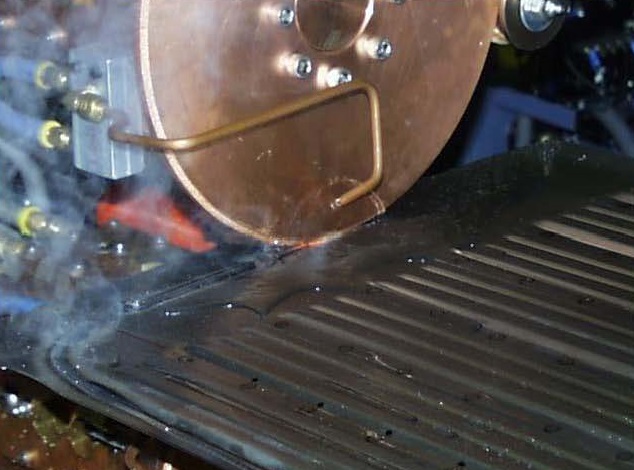To address this question we will assume that we are making a liquid tight seam weld. In this process the welds overlap as the weld wheels roll forward. In a seam weld the process current is developed to allow for shunting current through the trailing welds which have already been made.
This part has tack/spot welds occasionally to hold the two surfaces in place. When the weld wheels approach one of these tack/spot welds the weld conditions change. As the wheel approaches, increasing shunting current can now travel forward through the parent material and the tack/spot weld. This forward shunting path is not part of the normal current allowance. This portion of the current is no longer passing through the intended seam weld. Our seam weld will be cooler because less current went through the desired seam weld. This might lead to the seam weld decreasing in size and possible failure to meet specification.
When the wheel reaches the actual tack/spot weld, how rough is the surface? Is there a raised area around the tack/spot weld and a depression? Will it cause the weld wheel to use pressure to flatten this out? Will the wheel momentarily raise up and over the edge? In either scenario the wheel is not in intimate contact and flash and expulsion may result as it goes on and off the tack/spot weld. After the wheel leaves the tack/spot weld, it sees the tack/spot as just another seam weld and will weld normally till the next tack/spot weld is approached.
Another issue that happens as the seam wheel approaches a tack/spot weld is a possible gap between the two work pieces. A gap can happen with or without tack/spot welds. As described previously above, if the seam weld wheel must expend pressure to bring the pieces together, that force is not available to contain the weld. Lower effective force means that the weld will be hotter and the potential for expulsion increases. If expulsion is severe there is no metal remaining to hold the part together at that location and the liquid seal will fail. In short with or without tack welds the part should have a very snug fit between the components and not open gaps as the weld progresses.
Metal thermos bottles are an example where the diameters are fixed in size when the bottom is welded to the side sleeve. This must be a good fit between inner and outer part to insure a full seal to the entire bottom diameter. Thermoses are not tack/spot welded.
If tack/spot welds are an issue in your operation, are they necessary?
Can the part be held in place with a fixture? Can you reduce the number of tack/spot welds?
Can the control be programmed to compensate for the shunting current at each tack/spot weld?
Are the part tolerances sufficient for the process being performed?

Seam Welding with Flood Cooling
Related Article:"IS THERE A MINIMUM SPACING BETWEEN SPOT WELDS?"
References: RWMA – Resistance welding Manual, Revised 4th Edition

